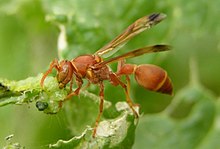Ropalidia marginata
| Ropalidia marginata | |
|---|---|
 |
|
| Ropalidia marginata | |
| Scientific classification | |
| Kingdom: | Animalia |
| Phylum: | Arthropoda |
| Class: | Insecta |
| Order: | Hymenoptera |
| Family: | Vespidae |
| Subfamily: | Polistinae |
| Tribe: | Ropalidiini |
| Genus: | Ropalidia |
| Species: | R. marginata |
| Binomial name | |
|
Ropalidia marginata Lepeletier, 1836 |
|
| Subspecies | |
|
|
Ropalidia marginata is an Old World species of paper wasp. It is primitively eusocial, not showing the same bias in brood care seen in other social insects with greater asymmetry in relatedness. The species employees a variety of colony founding strategies, sometimes with single founders and sometimes in groups of variable number. The queen does not use physical dominance to control workers; there is evidence of pheromones being used to suppress other female workers from overtaking queenship.
R. marginata was originally described by Fabricius in 1793 under the name Vespa ferruginea, but that name was previously applied to a different species, so the oldest available name for the species was given by Lepeletier in 1836. One of its subspecies, R. marginata jocund from New Guinea and Australia, was described in 1898, and two others, R. marginata rufitarsis from Myanmar and R. marginata sundaica from Indonesia and the Malay Peninsula, were described in 194.R. marginata is an insect, having six legs. It is in the order Hymenoptera, containing wasps, ants and bees. It is in the family Vespidae, with wasps, yellow jackets, and hornets. It is in the subfamily Polistinae, containing eusocial wasps and it is in the tribe Ropalidiini. On the Indian subcontinent, there are 22 recognized species of the genus Ropalidia. The species R. travancorica, once thought separate, was determined synonymous with R. marginata after intensive specimen comparisons in 1989. R. marginata is most closely related to R. spatulata and R. brevita. The male antenna and genitalia are similar between R. brevita and R. marginata.
R. marginata are a dark reddish color (slightly lighter than Ropalidia revolutionalis), with yellow spots on some joints and a yellow ring around the lower abdomen. Males differ from females by having a weaker mandible and lacking a stinger. The female workers are not morphologically different from the queen and are more distinguishable by behavior.
...
Wikipedia
